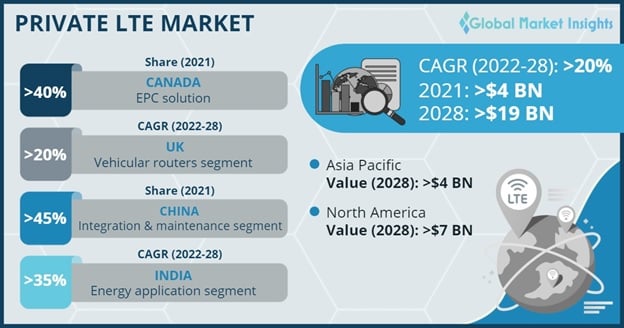


Private LTE Market
Get a free sample of this report
Your inquiry has been received. Our team will reach out to you with the required details via email. To ensure that you don't miss their response, kindly remember to check your spam folder as well!
Form submitted successfully!
Error submitting form. Please try again.

Request Sectional Data
Your inquiry has been received. Our team will reach out to you with the required details via email. To ensure that you don't miss their response, kindly remember to check your spam folder as well!
Form submitted successfully!
Error submitting form. Please try again.
Private LTE Market size exceeded USD 4 billion in 2021 and is projected to expand at over 20% CAGR from 2022 to 2028. Increasing adoption of private LTE networks to efficiently manage autonomous systems remotely will positively influence the market growth.

Private LTE networks offer low latency to operate autonomous systems, such as drills and drones, in harsh or remote environments. The private LTE technology is witnessing widespread usage in the mining sector as it helps the industry in automating key mining functions to gain operational efficiencies. A private LTE network leverages advanced radio access technologies to maximize the coverage and capacity to reach remote systems, vehicles, and field personnel.
Due to the COVID-19 pandemic, there has been an increase in the acceptance of wireless communication and digital technologies across diverse industries including defense and manufacturing. The commercialization of the 5G network driven by the pandemic across various countries has positively impacted the demand for private LTE solutions.
| Report Attribute | Details |
|---|---|
| Base Year: | 2021 |
| Private LTE Market size in 2021: | 4 Billion (USD) |
| Forecast Period: | 2022 to 2028 |
| Forecast Period 2023 - 2032 CAGR: | 20 |
| 2023 Value Projection: | 19 Billion (USD) |
| Historical Data for: | 2018 to 2020 |
| No of Pages: | 330 |
| Tables, Charts & Figures: | 618 |
| Segments Covered: | Component, Application and Region |
| Growth Drivers: |
|
| Pitfalls Challenges: |
|
In Canada, EPC solution in the private LTE market held 40% of revenue share in 2021 owing to its increasing adoption by organizations to address the increasing CAPEX. EPC dominates the market as it offers a unique integrated approach for delivering voice & data services and operates as a standalone system in large network deployments. EPC consists of a Serving Gateway, a PDN Gateway, a Mobile Management Entity (MME), and Home Subscriber Server (HSS), thus providing an architecture that can handle the data traffic efficiently. As mobile networks are becoming more complex with the introduction of LTE networks and multiple radio access technologies, the demand for EPC solutions to manage the network payload will increase during the forecast period.

In the UK, the vehicular routers segment is predicted to observe a 20% growth rate till 2028. The adoption of vehicular routers for mission-critical applications along with the requirement for robust connectivity coverage has increased significantly in the past couple of years. The acceptance of vehicular routers assists in providing high-speed data with control, security, & improved performance required in the transportation department, utility trucks, metro buses, and schools with bus fleets.
In China, integration & maintenance segment accounted 45% of the private LTE market share in 2021 due to the need to integrate private LTE networks for diverse industrial applications. Enhanced requirements for the integration of private LTE networks into public safety departments will also propel the industry growth. Furthermore, government initiatives for smart cities worldwide have resulted in increased connectivity requirements, accelerating the industry expansion for integration and maintenance services.
In India, the energy application segment is estimated to attain a CAGR of over 35% through 2028 impelled by the various smart city development initiatives and the deployment of advanced metering infrastructures across the globe. The usage of private LTE solutions assists in connecting distributed grid assets to ensure low costs over wide areas, enhance the bandwidth & spectral efficiency, and ensure that the grid & consumer data are always secure. New consumption patterns and the evolving trend of electric vehicles also contribute to the industry demand as these systems require a robust, highly secured, & reliable communication network.

North America private LTE market is anticipated to reach USD 7 billion by 2028 on account of the growing deployments of LTE networks in the defense sector. The rising demand for smart connected systems across various industry verticals, such as manufacturing, transportation, and urban planning, is expected to surge the demand for private LTE networks in the region. The public and private investments in the rapid commercialization of 5G network services are escalating the acceptance of diverse wireless networking technologies including private LTE networks.
Some of the key participants operating in the market are:
These companies are developing private LTE networks by partnering with other industry leaders in the ecosystem. These firms are deploying LTE solutions on their campuses to test the compatibility of various devices, ranging from smartphones to IoT. Such initiatives help companies to learn about the loopholes and drawbacks of the technology.
Market, By Component
Market, By Application
The above information has been provided for the following regions and countries:
The North America market is likely to generate USD 7 billion by 2028 owing to the rising deployment of these networks in the defense sector.
Private LTE networks provide low latency for operating autonomous systems, such as drills and drones, in harsh or remote environments.
The energy applications in India is pegged to observe a CAGR of more than 35% through 2028 led by the higher deployment of advanced metering infrastructures and the influx of various smart city development initiatives.
The market size of private LTE crossed USD 4 billion in 2021 and is poised to record a 20% CAGR between 2022 and 2028 due to the rising adoption of these networks to efficiently manage autonomous systems remotely.